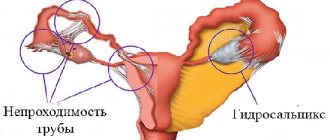In this section you will learn:
- Statistics on miscarriage
- How is miscarriage classified?
- Causes of miscarriage
- Causes of miscarriage at 5–6 weeks
- Causes of miscarriage at 7–10 weeks
- Causes of miscarriage at 10 weeks or more
- Causes of miscarriage at 15–16 weeks
- Causes of miscarriage at 22–27 weeks
- Causes of miscarriage at 28–37 weeks
- History taking
- Tests for miscarriage
- Management of pregnancy during miscarriage
- Treatment of miscarriage
- Prevention
Miscarriage is one of the main problems in modern gynecology and obstetrics. This pathology has acquired particular importance not only in medicine, but also in the social and economic spheres, since miscarriages negatively affect the level of population growth in the state.
Chronic miscarriage is a very specific phenomenon and is very different from one-time cases when a woman experiences spontaneous abortion. Recurrent miscarriage has a completely different etiology and pathogenesis, as well as specific pregnancy management. If you are planning a pregnancy or are already pregnant, it is worth familiarizing yourself with this pathology, which will help you determine the need to contact a specialist.
For many years, specialists from the company have been successfully fighting the pathology, who have already helped more than a dozen women become mothers, even with unfavorable prognosis. Contacting doctors of the highest category from our center will several times increase the chances of a successful pregnancy and childbirth.
Statistics on miscarriage
Miscarriage is a condition in which a woman loses a child at any time up to 259 days. The countdown is from the first day of the last menstruation, which means from the moment of conception, until 37 weeks. Chronic miscarriage - when there have been three or more miscarriages in the past.
In recent years, it has been common practice to divide miscarriage into two categories – primary and secondary. The primary includes cases when all of a woman’s pregnancies ended in miscarriage, and the secondary – when a woman not only lost the fetus, but also experienced an ectopic pregnancy, or had an abortion or had already given birth to children.
If we take into account the total number of all pregnancies, it can be noted that recurrent miscarriage is about 15–20%, of which 15% are premature births and not miscarriages. Statistics show that approximately 80% of miscarriages occur in the early stages of pregnancy.
There is an opinion that this is due to abnormalities in fetal development and is a variable factor. This is explained by the possibility of fertilization of an egg with abnormalities by a healthy sperm, or, conversely, fertilization of a healthy egg by a sperm with abnormalities in the chromosome set. Both lead to the conception of a non-viable fetus, which after some time is rejected by the woman’s body.
It is worth noting that such episodes are random, and their possibility is provided for by nature. Miscarriages in this case are the result of natural biological selection, and in the future they do not in any way affect the woman’s reproductive ability.
At the same time, if this happens once, the risk of a second miscarriage immediately increases by 12–17%, after the second case it increases to 25%, after the third - to 30%, and after the fourth - to 50%. If, having lost a child for the first time, a woman did not undergo treatment and was not in rehabilitation under the supervision of doctors, in half of the cases the situation repeats.
They are professionals in their field. Our doctors have contributed to the birth of healthy children in more than a dozen families. They know what to look for, what the specifics of pregnancy management will be in each individual case, and also draw up individual pregnancy management plans. This allows us to ensure that even women with an unfavorable medical history are able to bear and give birth to a child.
How is miscarriage classified?
How miscarriage is classified in any particular case determines how the doctor will manage the pregnancy. Today, there is no clear classification, since modern science only clarifies how strong the influence of already established factors on miscarriage is, and also determines factors that were previously unknown. However, depending on the period at which the miscarriage occurs, they are divided into:
- spontaneous termination - miscarriage before 28 weeks;
- premature delivery - childbirth between 28 and 37 weeks.
Spontaneous interruption is divided into early and late. The first case is the most common - up to 85% of miscarriages occur before 12 weeks. Late termination of pregnancy is considered to be from 13 to 21 weeks. If a spontaneous abortion occurs at 22–27 weeks, but the baby lives for 7 days, this is not called a miscarriage, but a premature birth.
For what reasons does miscarriage develop?
There are many factors that can lead to miscarriage. The most common are:
- heredity and genetics - there have already been cases of miscarriages in the family, the woman inherited problems from her parents;
- problems with the endocrine system;
- malfunctions of the immune system;
- there are blood clotting disorders;
- infection of the body of a woman and child during pregnancy;
- anatomical predisposition to fetal loss.
It is widely believed that chronic miscarriage is a consequence of the combination of several factors, which together do not allow pregnancy to proceed normally and prevent delivery from occurring. Such factors can act simultaneously or follow each other. At every stage of pregnancy there are dangerous periods. For each such period there are reasons that cause the threat of termination of pregnancy.
To avoid spontaneous abortion, contact specialists from. They will determine the cause of miscarriage in your case and select treatment and tactics for managing pregnancy with a favorable outcome.
5–6 weeks
At this stage, there are several reasons that lead to miscarriage. Namely:
- Genetic – determined by the specific karyotype of the parents. Such disorders may involve the presence of chromosomal abnormalities. This can be translocation (when a section of one chromosome is transferred to another section or another chromosome, or an exchange of sections on non-homologous chromosomes has occurred), inversion (when a section of a chromosome is rotated 180°), deletion (when a section of a chromosome has fallen out or separated), duplication ( when the area has doubled), mosaicism (when the cells in the tissues are genetically different), etc. - after 35 years in women, the risk of such a pathology increases.
- The leukocyte antigen compatibility level is too high.
- The endometrium contains many large granular lymphocytes that are toxic to viruses or tumor tissues. This leads to the fact that the pregnant woman’s body cannot receive impulses from the fetus and respond adequately to them.
- There are too many anti-inflammatory cytokines in the blood, which are the response of the immune system.
7–10 weeks
At this stage, the causes of miscarriages are mainly hormonal disorders. The endocrine and immune systems of a pregnant woman’s body come into conflict, and due to a hormonal imbalance, pregnancy is terminated in 30–80% of cases. Endocrine disorders lead to functional and structural changes in the corpus luteum, which provokes a decrease in progesterone in the blood.
Hormonal disorders in most cases express themselves in:
- too short luteal phase (regardless of the causes of the phenomenon) – causes 20–60% of miscarriages;
- hyperandrogenism due to impaired follicle formation or diseases of the hypothalamus and pituitary gland;
- increased levels of prolactin in the blood in diseases of the thyroid gland - hypo- and hyperthyroidism;
- a decrease in estrogen at the time of determining the dominant follicle;
- over- and underdevelopment of the fertilized egg;
- inferiority of the luteal body;
- problems with the formation of uterine tissue (endometrium).
As a result of all the above reasons, the secretory functions of the endometrium are defective, and the uterine mucosa is not ready for pregnancy. There is an opinion that the body reacts to progesterone as an allergen, as a result of which spontaneous abortions occur.
10 weeks or more
Miscarriages at this stage occur mostly due to malfunctions of the immune system. Fetal development mainly depends on the normal functioning of the fetoplacental system, which consists of the circulatory systems of the mother, placenta and child. The regulation function is assigned to the placenta.
The placenta itself is responsible for the production and saturation of the blood with biologically active proteins and hormones, which do not allow the body to perceive the fetus as foreign. It is the placenta that will be responsible for the production of an adequate number of lymphocytes and the normal immune response of the maternal body to the development and preservation of the fetus.
Malfunctions in the functioning of the immune system can be:
- autoimmune;
- alloimmune.
The first case involves a hostile perception by the immune system of the tissues of one’s own body, due to which the fertilized egg will be subject to attack. In the second case, the father’s genes are perceived as hostile, and the body begins the process of cell destruction.
Hematogenous thrombophilias are a consequence of autoimmune disorders and are bleeding disorders that are genetically determined. One of the most common abnormalities is the syndrome, which consists in the fact that the body creates antibodies to its own phospholipids. As a result of this syndrome, vascular thrombosis, placental infarction, placental abruption and development of insufficiency occur, as well as the appearance of pregnancy gestosis.
15–16 weeks
The most common causes of miscarriages at this stage are infections and isthmic-cervical insufficiency (ICI): the cervix opens when the embryo is still in the process of development, which can lead to termination of pregnancy.
Infectious causes may occur due to the body suppressing local immune responses. As a result, fungal microorganisms and other infections are activated and begin to actively multiply, which leads to kidney disease, as well as inflammation of the genital tract mucosa.
The opening of the cervix, otherwise called ICM, is provoked by pathogens of various types of infections and leads to the fact that the uterine tissues begin to become inflamed. As a result, the tone of the uterus increases, the muscles begin to contract and premature loss of amniotic fluid may occur.
The most dangerous during this period are:
- genital mycoplasmosis – fetal loss occurs in more than 65% of cases;
- cytomegalovirus infection – the risk is above 30%;
- chlamydial cervicitis – more than 15%;
- bacterial colpitis – 15%;
- mycoplasma colpitis and cervicitis - up to 10% risk of miscarriage.
22–27 weeks
The main reasons for spontaneous pregnancy loss and fetal loss by a woman are as follows:
- opening of the cervix at the time of fetal development (FDM);
- the amniotic sac sags;
- amniotic fluid has broken prematurely;
- the body is infected;
- fetal development abnormalities;
- Multiple pregnancy is complicated by infection.
28–37 weeks
As a rule, at 28–30 weeks the risk of miscarriage is lower and is slightly more than 30%. The remaining cases of spontaneous abortion occur at 34–37 weeks. Preterm birth can have the same consequences as a normal full-term birth. The cause of premature birth may be the following:
- anti-inflammatory cells grow due to acute bacterial or viral infection - in approximately 40% of cases;
- water breaks prematurely, which may be due to infection - 30% of cases;
- placental insufficiency and fetal hypoxia resulting from gestosis or diseases of the woman’s body systems;
- stress of a pregnant woman, which provokes a surge of hormones and, as a result, placental insufficiency;
- autoimmune causes leading to placental abruption, placental infarction, etc.;
- overextension of the reproductive organ due to multiple fetuses or polyhydramnios;
- malfunctions of the endometrial receptor apparatus;
- adhesions in the uterus, neoplasms, defects in its development.
Factors can combine to increase the risk of fetal loss. It is worth noting that there is no specific gene for spontaneous abortion: the pathology is caused by a variety of reasons, often a combination of them.
Diagnosis of pregnancy failure and examination of the pregnant woman at each stage
Having learned how many reasons there are for miscarriage, it is worth noting that the diagnosis and recommendations will depend entirely on the professionalism of the doctors who are caring for the pregnancy. You will find the most experienced doctors of the highest category in. They will comprehensively assess the situation and order all the necessary studies.
History taking
In most cases, this step allows you to find out why there is a risk of miscarriage. When taking a medical history, the doctor asks the patient the following:
- Are there genetic diseases, cases of stillbirth, or deviations from normal development in the family of the wife and husband? It is especially important to find out whether there have been any cases of disruptions in cerebral circulation, thrombosis, heart attacks, etc. A woman will be asked how many children are in her family, what number of children she was born in, and whether she was born at term, since miscarriage is often inherited.
- Social conditions and diseases that the woman suffered. The doctor clarifies the frequency of infections, the presence of chronic diseases such as rheumatism, tonsillitis, etc., as well as whether extragenital diseases have occurred and whether they entailed complications.
- Everything about the menstrual cycle - its duration, regularity, etc. Polycystic ovary syndrome, congenital hyperplasia, infantilism, abnormal development of the reproductive organs, etc. are often detected.
- Are there any chronic diseases of the reproductive system, how often do they worsen and whether appropriate treatment was carried out, if so, what was its nature - medicinal or surgical (cryotherapy, laser therapy, etc.).
- Everything about a woman’s reproductive function - when she began sexual activity, how contraception was performed, whether there are abortions, whether there were miscarriages or premature births, whether the woman has children, what was the gestational age before the miscarriage, if any, was there any infertility between pregnancies and other.
Collecting this information allows doctors to determine which path a woman should take to further evaluate her and what procedures she may need. Also, along with this, a pregnancy management protocol will be developed.
Examination for miscarriage
It consists of several stages - a general examination by an obstetrician-gynecologist, examination of the condition of the reproductive organs in a gynecological chair and the appointment of studies of biomaterial in a laboratory or using special medical equipment.
- General inspection
It is carried out by a gynecologist on the organs and systems of the body. Particular attention will be paid to the physique of the pregnant woman, which will help identify problems with metabolism and hormonal imbalances; height and weight are taken into account, body mass index is calculated, the presence of excess hair on the body and face, obesity and its nature (if any), and how well secondary sexual characteristics are expressed. The presence of stretch marks on the skin, their severity and area of location, the condition of the heart and blood vessels, and liver are also important.
The presence of stressful conditions and neurotic disorders may be indicated by the patient's chilliness, excessive sweating, unstable psychological and emotional state, excitability or lethargy, temperature, skin color and moisture, number of heartbeats per minute and blood pressure readings.
- Gynecological examination
The doctor will determine the type of hair growth of the woman, determine whether there are scars on the cervix and what size is the external os of the cervical canal, whether isthmic-cervical insufficiency can form, what size is the cervix. An examination by a gynecologist will reveal inflammation, condylomas and deficiencies in the development of the reproductive organ, whether there are tumor processes, and also what size the ovaries are.
- Special studies
Divided into two stages. At the first stage, the condition of the reproductive organs is assessed and common causes of fetal development disorders are determined; at the second stage, it is clarified for what reasons the woman is faced with recurrent miscarriage. Research methods may be as follows:
- determining the condition of the fetus using ultrasound;
- assessing the condition of the uterine cavity and checking the patency of the fallopian tubes;
- laparoscopy (if necessary);
- MRI or sonosalpingography;
- calculation of basal temperature chart;
- research of biological materials in a laboratory setting.
Laboratory research can include a whole range of activities. These include hormone testing. It is needed in order to determine the cause of luteal phase deficiency, whether hormonal levels are disrupted, which in the future will make it possible to select medications to maintain pregnancy. In the appropriate phases of the menstrual cycle, studies will be prescribed to determine the level of:
- luteinizing (LH), thyroid-stimulating (TSH) and follicle-stimulating (FSH) hormones;
- mammotropin;
- testosterone;
- estrogen;
- free thyroxine (T4).
If necessary, tests for other hormones may be prescribed if the doctor has reason to suspect hyperandrogenism.
Immunity testing is necessary to determine whether there are immunoglobulins in the blood, whether there are antibodies to phospholipids, glycoproteins and prothrombin, thyroid hormones, etc. In addition, interferon status will be determined, as well as the content of anti-inflammatory and regulatory cytokines.
- Tests for bacteria and viruses
To do this, you need to provide urine, as well as smears from the vagina, cervix and, sometimes, the uterus itself. This is necessary in order to determine not only the presence of pathogens, but also antibodies to them.
- Coagulogram
This study is a comprehensive assessment of the blood coagulation system and is otherwise called a hemostasiogram. As part of the hemostasiogram, a lot of methods and indicators have been developed, but the following are mainly used:
- thromboelastography, which displays the dynamics of blood clotting. Allows you to determine the mechanical qualities of a non-globular protein formed from fibrinogen, as well as monitor how a blood clot is created and dissolved;
- coagulogram - displays the prothrombin index and time, active partial thromboplastin time and activated time during which oxalate plasma will clot after calcium chloride is added to it;
- platelet aggregation and other indicators.
- Genetic research
They are needed mainly when the couple is over 35 years old, and in the past there have been cases of stillbirth, early miscarriages, and fetal preservation techniques have proven ineffective. The study has two stages and is carried out with the help of medical genetic consultation. The stages are:
- studying the pedigree of a married couple, with an analysis of cases of problems with pregnancy - this makes it possible to determine whether spontaneous abortions are accidental or natural;
- cytogenetic study - study of the karyotype of a man and a woman, identifying any abnormalities in the chromosomes of partners.
A study is also being carried out on leukocyte antigens, which are responsible for the body’s identification of its own and foreign tissues.
Doctors will prescribe all the blood tests necessary to identify the causes of miscarriage. This will allow us to develop pregnancy management tactics and provide a woman with the opportunity to become a mother, carrying and giving birth to a healthy baby.
How is pregnancy carried out?
The protocol for managing women with normal pregnancies is basic for everyone. The difference is that pregnant women with pathology will undergo a greater number of examinations in case of identified and suspected causes of miscarriage.
When a pregnant woman registers and visits the doctor for the first time, she will be examined and interviewed, after which the gynecologist will prescribe a transvaginal ultrasound and laboratory tests of biomaterial, which are planned by the basic protocol. If this stage determines thrombophilia, it will be necessary to find out its cause and prescribe adequate treatment.
Among other things, a marker of placental insufficiency (trophoblastic globulin) is determined. If its level is low, this will indicate a risk of miscarriage. If a woman has the first blood group, and the father of the child has a second or third, an analysis is prescribed for the presence of group antibodies. With different Rh factors in the child’s parents, Rh antibodies in the mother’s blood are also determined.
Professionals know what decisions to make even in the most difficult cases. Their job is to make every effort to ensure that the woman is able to maintain her pregnancy and give birth to a child. Doctors of the highest category will inform the expectant mother about all the actions and procedures that are needed in her case, and will also select adequate treatment if deviations from the norm are detected.
Examinations in the second half of pregnancy are performed depending on the risks of miscarriage.
- 15–20 week
An examination of the cervix and an ultrasound are performed, which is aimed at identifying isthmic-cervical insufficiency. If it is determined, surgery is recommended. Scrapings from the vagina and cervix are needed to determine the level of white blood cells. If it is elevated, additional research will be needed for fungi, viruses and other pathogenic microorganisms. A study is also needed to rule out the presence of Down syndrome in the child. Taking into account the patient’s age and her state of health, the abdominal wall and uterus can be punctured to collect amniotic fluid.
- Week 24
At this time, a glucose tolerance test, transvaginal ultrasound examination is performed, and a cervical examination by a gynecologist may be prescribed (applies to women at risk). Scrapings are taken from the cervical canal to exclude infectious fungal diseases, as well as pathogenic bacteria. Doppler ultrasound is also needed to assess blood flow in the uterus, placenta and around the fetus.
- 28–32 weeks
It examines how mobile the fetus is and controls the tone of the uterus; a transvaginal ultrasound examination can be performed for pregnant women at risk. Rh sensitization is prevented, if the woman’s Rh factor is negative and there are no antibodies in the blood, the hemostasiogram is monitored again. Vaginal infections, if any, are treated. Research will be needed to determine the presence of markers in the woman’s blood that indicate the risk of miscarriage or premature birth, as well as determination of hormone levels.
If necessary, the pregnant woman is hospitalized and treated in a hospital setting, and distress syndrome is prevented in the child. If a woman is at risk, placental insufficiency will need to be prevented.
- 34–37 weeks
The tone of the uterus is controlled, and with the help of tocography it is determined in what state the fetus’s body is. The pregnant woman's blood is examined for sugar and total protein, as well as leukocytes. A general urine test is performed, and if leukocytes are detected in it, you will need to perform a Nechiporenko test for the presence of bacterial infections. If indications appear, it may be necessary to determine the presence of antibodies in the blood that are produced in response to the entry of Rh erythrocytes of the embryo into the circulatory system, as well as antibodies to fetal blood cells of another group.
A hemostasiogram is repeated, a scraping of the vaginal mucosa is taken, if it is found that the level of leukocytes exceeds the norm, a test for bacteria will be performed. At week 37, tests are planned for hepatitis and human immunodeficiency virus, and an analysis for antibodies to Treponema pallidum.
Specialists know what tests need to be ordered to determine the health status of the mother and fetus and predict the further course of pregnancy. By contacting them, you can be sure: your family happiness is in good hands.
When can you get pregnant after a miscarriage?
A woman is not recommended to try to become pregnant until she is physically and emotionally ready and has completed all the investigations recommended to identify the causes of miscarriage.
From a medical point of view, conception is safe from the moment of at least one menstrual cycle (if no research or treatment is carried out on the causes of previous miscarriage).
However, it may take much longer before a woman is emotionally ready for pregnancy. Fortunately, the vast majority of women who have experienced one or two miscarriages do not suffer from infertility and successfully carry their next pregnancy to term.
How to treat miscarriage
In many ways, treatment tactics will depend on what causes led to the miscarriage. For example, if the luteal phase is too short, antispasmodics and sedatives of herbal origin will be prescribed. For this purpose, No-shpa, valerian tincture, etc. are used. Magne-B6 and hormonal drugs, for example Duphaston, are often prescribed.
If hypersensitivity to progesterone is detected, glucocorticoids, Duphaston, immunoglobulins are used, as well as immunotherapy by administering lymphocytes from the child’s father. This reduces the level of immune system response and prevents the mother’s body from rejecting the genetic material of the child’s father.
Placental insufficiency is prevented and treated with Piracetam, Actovegin, Infezol. If the fetal fluid leaves prematurely due to infection, tocolytic medications, antibiotics, and drugs against bacteria and fungi are used.
If there is a risk of miscarriage, the woman is advised to rest; treatment may be prescribed with magnesium sulfates, hexoprenaline, salbutamol and terbutaline, as well as fenoterols, hormonal drugs and anti-inflammatory drugs such as Indomethacin, which do not have the undesirable consequences inherent in steroids. For uterine hypertonicity, alternating current is applied to the muscular and nervous system of the uterus and acupuncture is prescribed to relax the muscles and reduce the level of muscle contractions leading to the risk of miscarriage or premature birth.
Plasmocytopheresis may be prescribed - up to three sessions. It consists in the fact that during a session, 0.6–1 liters of plasma is removed from the entire blood volume and special solutions are introduced to replace it. Thanks to this, toxins and antigens are partially removed, blood microcirculation improves, and high coagulability is reduced; if medications are poorly tolerated, this way it is possible to reduce their dosage.
It is clear that each situation requires its own approach, and there is no single treatment tactic. Specialists undertake to determine the reasons why a woman cannot bear a child, and prescribe examinations and treatment that will significantly reduce the risk of spontaneous abortion or reduce it to zero.
How is prevention done?
Prevention of miscarriage is a rather complex process, which entirely depends on the professionalism of the doctor. Prevention must follow several basic principles. Namely:
- identification of patients who are at risk of miscarriage;
- a thorough examination of a man and a woman before pregnancy and preparation of the body of the future mother for conception, subsequent pregnancy and delivery;
- regular monitoring of the condition of the pregnant woman’s body and identification of infectious and inflammatory processes, timely competent therapy aimed at relieving inflammation, eliminating bacteria and viruses, supporting the immune system - for this, every month the woman submits scrapings of the mucous membranes, urine for bacteria, blood and biomaterial to determine signs of infection fruit, etc.;
- determination of cervical insufficiency by examination, as well as transvaginal ultrasound up to 24 weeks; if there is not one fetus, but two or more - up to 27 weeks;
- treatment for identifying extragenital diseases, forecasts regarding the effect of the disease and its treatment on the fetus;
- determination of thrombophilia and placental insufficiency, their proper treatment and prevention in the early stages.
If it is determined that during pregnancy and childbirth the patient or her child faces negative consequences that cannot be avoided, she will be provided with comprehensive information regarding the state of her health and the health of the embryo, the consequences, as well as alternative methods of managing pregnancy and childbirth.
A lot depends on the professionalism of the doctor, who will be involved in ordering studies, interpreting their results, and selecting treatment. To be sure that you are in good hands, we advise you to contact doctors of the highest category from. Their work experience, as a rule, ensures pregnancy even in the most difficult cases.
If pregnancy management tactics and treatment do not prevent spontaneous abortion, and you are faced with the problem of infertility, our reproduction center will select other options for you. Among them, in vitro fertilization, collection of female or male biomaterial, and surrogacy are usually considered.
Infectious causes
They are the most common factor leading to termination of pregnancy. Viruses and bacteria are the main cause of intrauterine infection in the fetus, as well as inflammatory diseases in the mother. Both of these can lead to severe complications and termination of pregnancy.
For example, the rubella virus has a very serious effect on the development of the unborn child. If damage to developing organ systems is incompatible with life, the fetus may die or its condition may cause a miscarriage. The same applies to toxoplasma, which affects the fetal nervous system, visual organs, etc. Some viruses and microbes damage not only the cells of the fetus, but also the placenta and membranes, on which the nutrition, breathing and protection of the unborn child depend. When the placenta cannot function normally, the continuation of pregnancy is at risk.
Infections also cause inflammatory diseases of the genital organs - endocervicitis, colpitis, etc. - and cause disruption of their functions and the development of unexpected contractions of the uterus. All this can also cause miscarriage. According to research, a genital infection ends in miscarriage in approximately every sixth pregnant woman.
Hormonal reasons
Hormones are responsible for the readiness of a woman’s body for pregnancy. If the balance of hormones in the blood is disturbed, the uterine mucosa does not have time to prepare in time to strengthen the egg on it; as a result, the embryo develops in unfavorable conditions and does not receive enough nutrients. Therefore, at a certain point, all violations reach a critical level and the pregnancy is terminated.
For a favorable pregnancy, the normal functioning of the thyroid gland, adrenal glands, and ovaries is important. Sex hormones are responsible for the development of the placenta, the lining of the uterus, and prevent its next rejection (as during menstruation). The thyroid gland and adrenal glands are responsible for the normal metabolic rate in the body of the expectant mother, ensuring a timely and sufficient supply of all nutrients to the child.
Diagnosis of miscarriage
The first step to solving the problem of miscarriage is to determine its cause. If the problem is related to the anatomy of the genital organs or a disruption of their normal structure after an illness or injury, then treatment for miscarriage can only be surgical. Ultrasound, MRI and gynecological examination can help detect this problem.
A consultation with a geneticist and a genetic examination will identify problems with the hereditary material and give an approximate prognosis for the likelihood of having a healthy child.
Early diagnosis of sexually transmitted infections helps to get rid of many potential problems associated with intrauterine infections and developmental defects that arise as a result of them. The main way to thoroughly check the body for infections dangerous to pregnancy is a laboratory test of blood and smears from the genital tract.
Constitutional reasons
Sometimes the uterus and other female genital organs have congenital or acquired deviations from the normal structure. These deviations interfere with the normal attachment of the future embryo to the uterine mucosa. A similar problem occurs with a bicornuate uterus, intrauterine septum, as well as with tumors in the uterine cavity (fibroids) or with postoperative scars of its wall. It happens that the fertilized egg does not even get inside the uterus, because it encounters an obstacle along the way. The obstacle may be adhesions that arise after inflammation, or congenital narrowing of the lumen of the fallopian tube.
What tests are needed to prevent miscarriage?
Tests for the TORCH complex allow timely detection of rubella viruses, active herpes virus, cytomegalovirus, as well as toxoplasma, mycoplasma and ureaplasma. A blood test called RPR (microprecipitation reaction with cardiolipin antigen) detects infection with syphilis, which poses a serious danger to both the child and the expectant mother. In case of a positive result, an additional blood test is prescribed for Antibodies to Treponemapallidum (total) ELISA or RPGA with treponemal antigen. A blood test for HIV is required.
All these tests are necessary not only to eliminate the risks of miscarriage, but also to protect the child from congenital malformations and infection with HIV, hepatitis, etc.
Blood test for hormones - allows you to make sure that the hormonal balance of the expectant mother does not have deviations and will contribute to the correct formation of the fetus and placenta and their strong strengthening in the uterine cavity.
Correctly performed laboratory diagnostics can help identify the causes of miscarriage or prevent the development of this problem.








